BUS750: Education Management System in New Zealand, Semester 2 Report
VerifiedAdded on 2022/08/13
|5
|904
|11
Report
AI Summary
This report provides an overview of the education management system in New Zealand, covering early childhood, primary, secondary, and tertiary education. The report begins with an introduction that outlines the three-step process of education in New Zealand and the structure of the academic year. The literature review and secondary data section discusses key facts about the system, including its student-centered approach and the importance of early childhood education. The methodology section highlights the use of psychological interviewing for primary data collection. The report also addresses changes of direction and constraints in the evaluation testing method, and it concludes with future research task planning, including the identification of schools and the development of a research timetable. The report references relevant literature to support its findings.
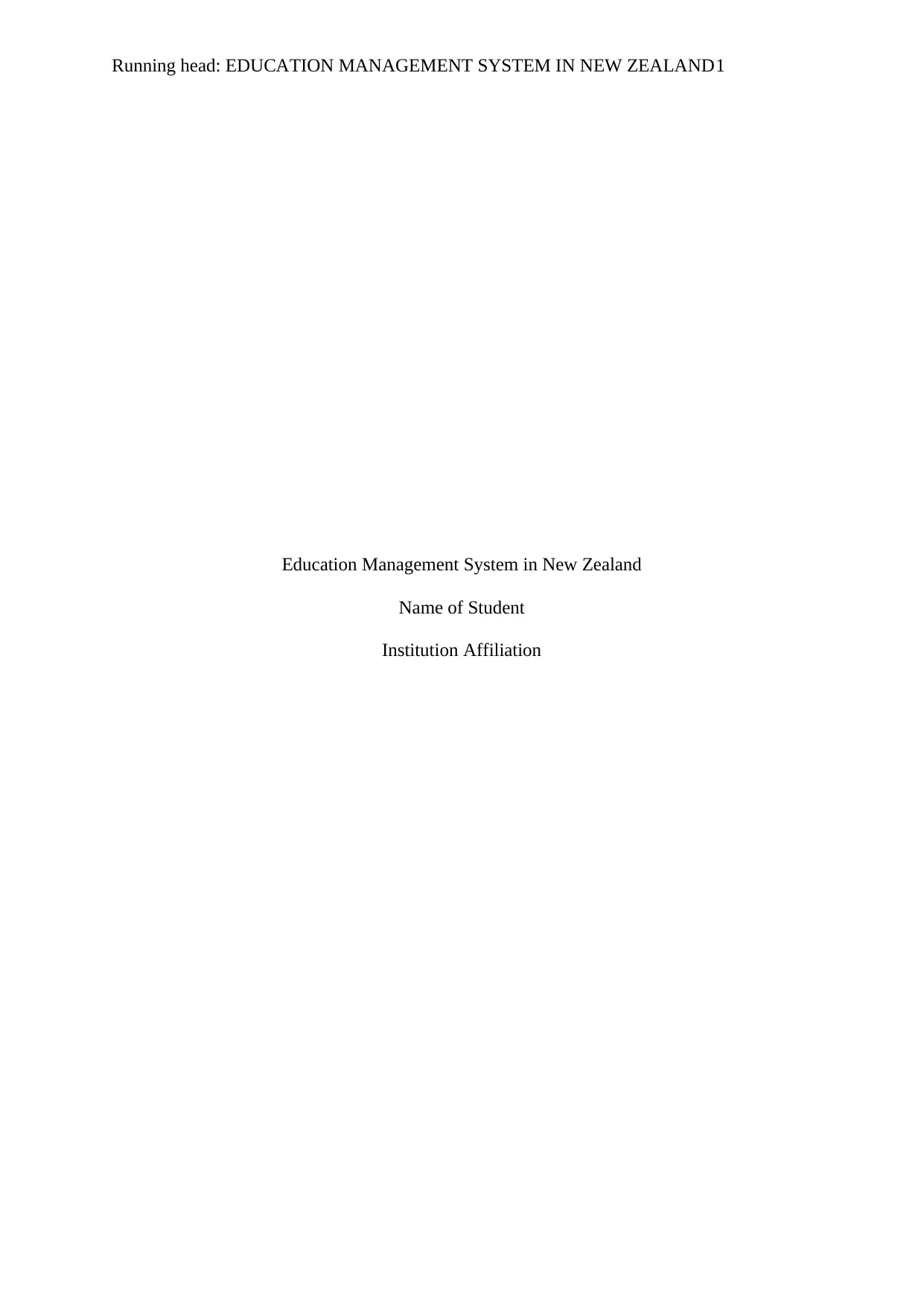
Running head: EDUCATION MANAGEMENT SYSTEM IN NEW ZEALAND1
Education Management System in New Zealand
Name of Student
Institution Affiliation
Education Management System in New Zealand
Name of Student
Institution Affiliation
Paraphrase This Document
Need a fresh take? Get an instant paraphrase of this document with our AI Paraphraser
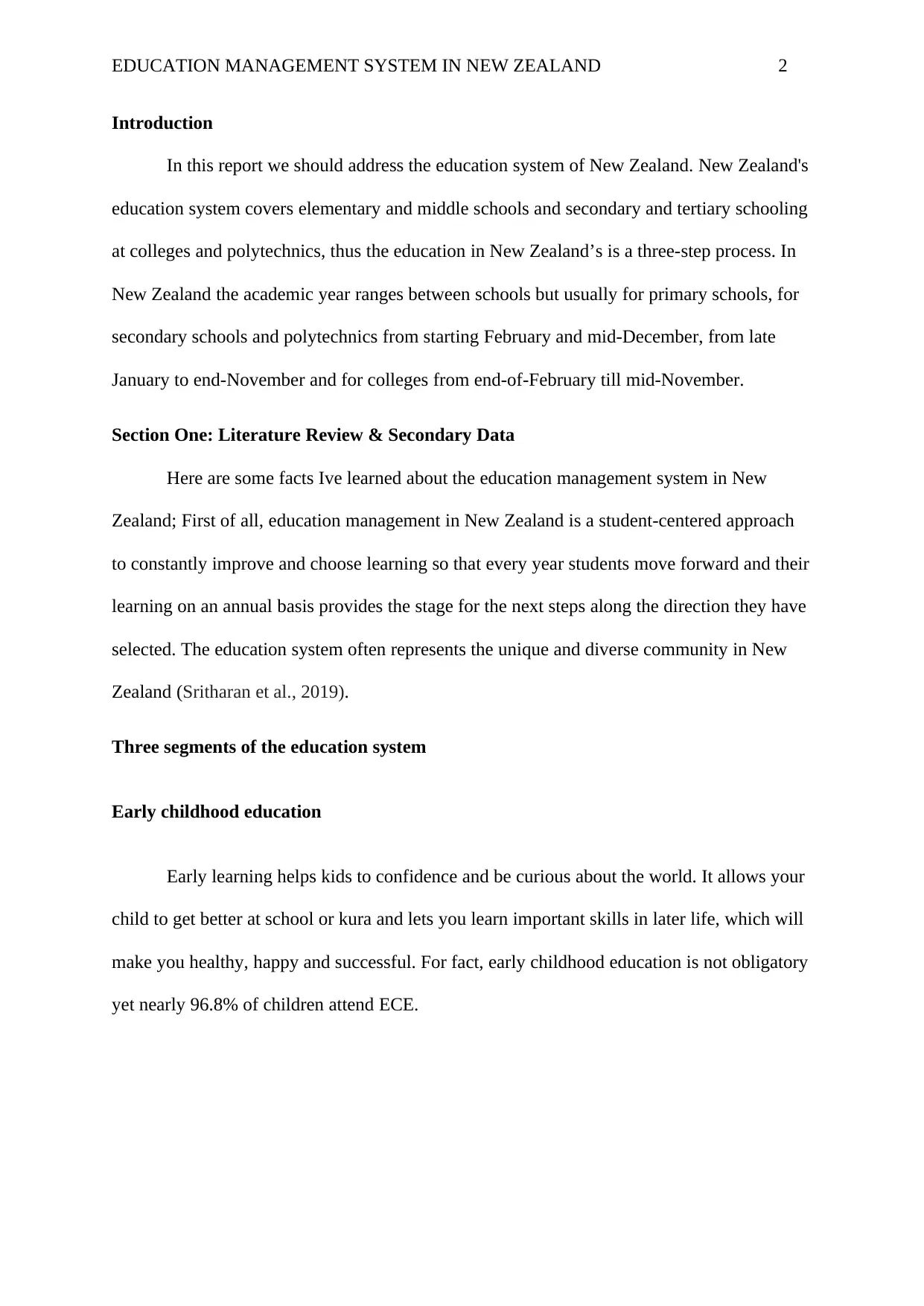
EDUCATION MANAGEMENT SYSTEM IN NEW ZEALAND 2
Introduction
In this report we should address the education system of New Zealand. New Zealand's
education system covers elementary and middle schools and secondary and tertiary schooling
at colleges and polytechnics, thus the education in New Zealand’s is a three-step process. In
New Zealand the academic year ranges between schools but usually for primary schools, for
secondary schools and polytechnics from starting February and mid-December, from late
January to end-November and for colleges from end-of-February till mid-November.
Section One: Literature Review & Secondary Data
Here are some facts Ive learned about the education management system in New
Zealand; First of all, education management in New Zealand is a student-centered approach
to constantly improve and choose learning so that every year students move forward and their
learning on an annual basis provides the stage for the next steps along the direction they have
selected. The education system often represents the unique and diverse community in New
Zealand (Sritharan et al., 2019).
Three segments of the education system
Early childhood education
Early learning helps kids to confidence and be curious about the world. It allows your
child to get better at school or kura and lets you learn important skills in later life, which will
make you healthy, happy and successful. For fact, early childhood education is not obligatory
yet nearly 96.8% of children attend ECE.
Introduction
In this report we should address the education system of New Zealand. New Zealand's
education system covers elementary and middle schools and secondary and tertiary schooling
at colleges and polytechnics, thus the education in New Zealand’s is a three-step process. In
New Zealand the academic year ranges between schools but usually for primary schools, for
secondary schools and polytechnics from starting February and mid-December, from late
January to end-November and for colleges from end-of-February till mid-November.
Section One: Literature Review & Secondary Data
Here are some facts Ive learned about the education management system in New
Zealand; First of all, education management in New Zealand is a student-centered approach
to constantly improve and choose learning so that every year students move forward and their
learning on an annual basis provides the stage for the next steps along the direction they have
selected. The education system often represents the unique and diverse community in New
Zealand (Sritharan et al., 2019).
Three segments of the education system
Early childhood education
Early learning helps kids to confidence and be curious about the world. It allows your
child to get better at school or kura and lets you learn important skills in later life, which will
make you healthy, happy and successful. For fact, early childhood education is not obligatory
yet nearly 96.8% of children attend ECE.
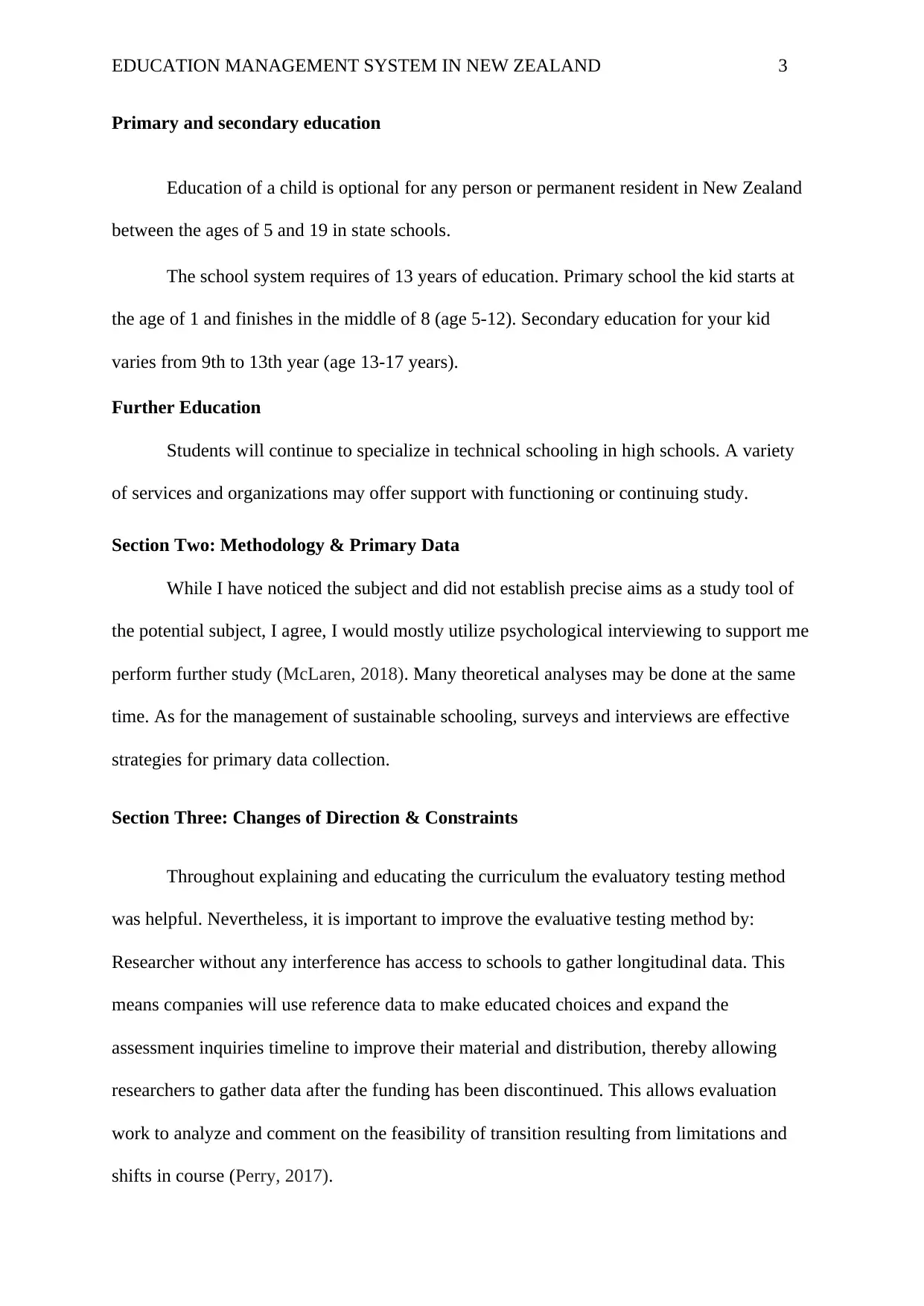
EDUCATION MANAGEMENT SYSTEM IN NEW ZEALAND 3
Primary and secondary education
Education of a child is optional for any person or permanent resident in New Zealand
between the ages of 5 and 19 in state schools.
The school system requires of 13 years of education. Primary school the kid starts at
the age of 1 and finishes in the middle of 8 (age 5-12). Secondary education for your kid
varies from 9th to 13th year (age 13-17 years).
Further Education
Students will continue to specialize in technical schooling in high schools. A variety
of services and organizations may offer support with functioning or continuing study.
Section Two: Methodology & Primary Data
While I have noticed the subject and did not establish precise aims as a study tool of
the potential subject, I agree, I would mostly utilize psychological interviewing to support me
perform further study (McLaren, 2018). Many theoretical analyses may be done at the same
time. As for the management of sustainable schooling, surveys and interviews are effective
strategies for primary data collection.
Section Three: Changes of Direction & Constraints
Throughout explaining and educating the curriculum the evaluatory testing method
was helpful. Nevertheless, it is important to improve the evaluative testing method by:
Researcher without any interference has access to schools to gather longitudinal data. This
means companies will use reference data to make educated choices and expand the
assessment inquiries timeline to improve their material and distribution, thereby allowing
researchers to gather data after the funding has been discontinued. This allows evaluation
work to analyze and comment on the feasibility of transition resulting from limitations and
shifts in course (Perry, 2017).
Primary and secondary education
Education of a child is optional for any person or permanent resident in New Zealand
between the ages of 5 and 19 in state schools.
The school system requires of 13 years of education. Primary school the kid starts at
the age of 1 and finishes in the middle of 8 (age 5-12). Secondary education for your kid
varies from 9th to 13th year (age 13-17 years).
Further Education
Students will continue to specialize in technical schooling in high schools. A variety
of services and organizations may offer support with functioning or continuing study.
Section Two: Methodology & Primary Data
While I have noticed the subject and did not establish precise aims as a study tool of
the potential subject, I agree, I would mostly utilize psychological interviewing to support me
perform further study (McLaren, 2018). Many theoretical analyses may be done at the same
time. As for the management of sustainable schooling, surveys and interviews are effective
strategies for primary data collection.
Section Three: Changes of Direction & Constraints
Throughout explaining and educating the curriculum the evaluatory testing method
was helpful. Nevertheless, it is important to improve the evaluative testing method by:
Researcher without any interference has access to schools to gather longitudinal data. This
means companies will use reference data to make educated choices and expand the
assessment inquiries timeline to improve their material and distribution, thereby allowing
researchers to gather data after the funding has been discontinued. This allows evaluation
work to analyze and comment on the feasibility of transition resulting from limitations and
shifts in course (Perry, 2017).
⊘ This is a preview!⊘
Do you want full access?
Subscribe today to unlock all pages.

Trusted by 1+ million students worldwide
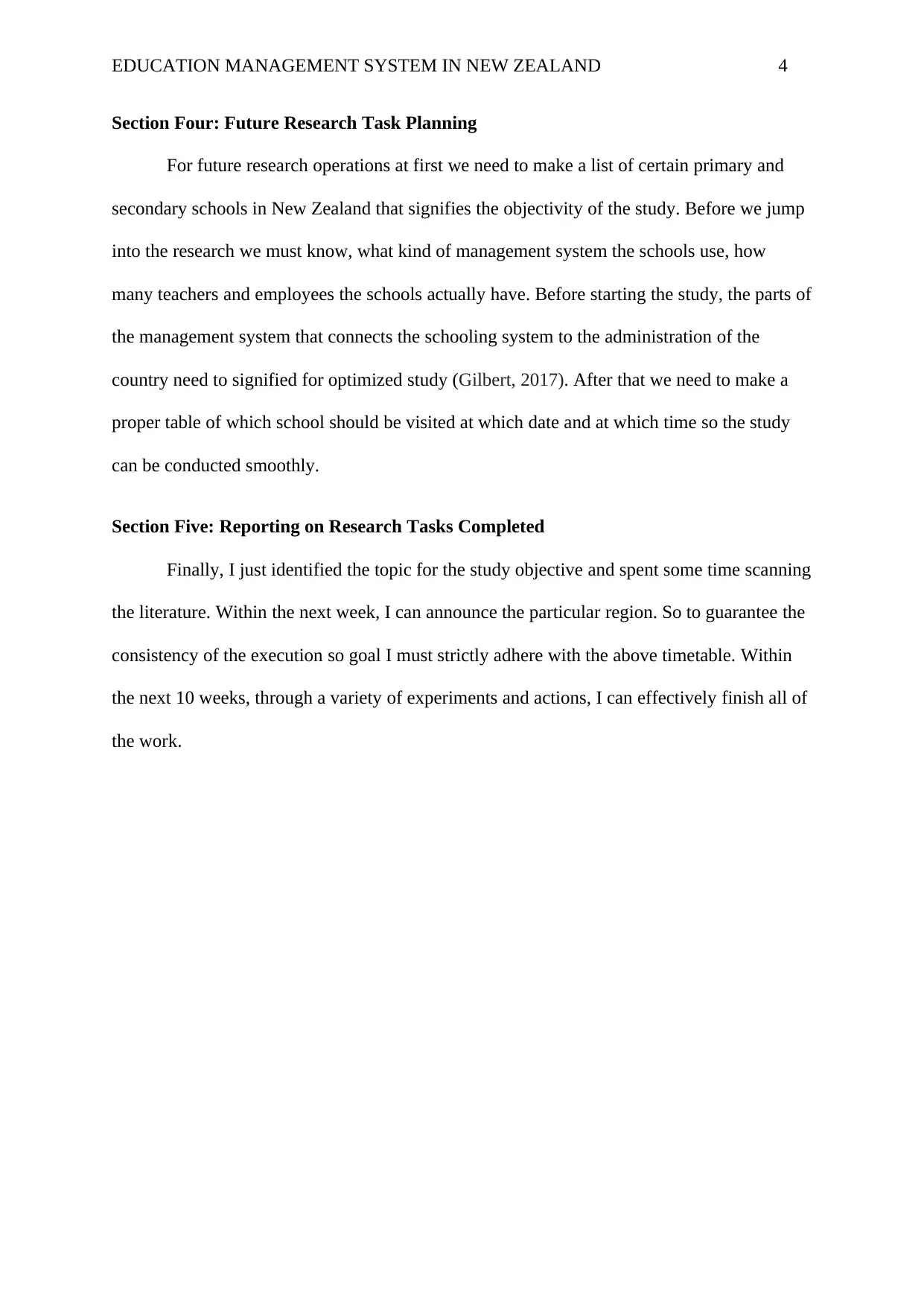
EDUCATION MANAGEMENT SYSTEM IN NEW ZEALAND 4
Section Four: Future Research Task Planning
For future research operations at first we need to make a list of certain primary and
secondary schools in New Zealand that signifies the objectivity of the study. Before we jump
into the research we must know, what kind of management system the schools use, how
many teachers and employees the schools actually have. Before starting the study, the parts of
the management system that connects the schooling system to the administration of the
country need to signified for optimized study (Gilbert, 2017). After that we need to make a
proper table of which school should be visited at which date and at which time so the study
can be conducted smoothly.
Section Five: Reporting on Research Tasks Completed
Finally, I just identified the topic for the study objective and spent some time scanning
the literature. Within the next week, I can announce the particular region. So to guarantee the
consistency of the execution so goal I must strictly adhere with the above timetable. Within
the next 10 weeks, through a variety of experiments and actions, I can effectively finish all of
the work.
Section Four: Future Research Task Planning
For future research operations at first we need to make a list of certain primary and
secondary schools in New Zealand that signifies the objectivity of the study. Before we jump
into the research we must know, what kind of management system the schools use, how
many teachers and employees the schools actually have. Before starting the study, the parts of
the management system that connects the schooling system to the administration of the
country need to signified for optimized study (Gilbert, 2017). After that we need to make a
proper table of which school should be visited at which date and at which time so the study
can be conducted smoothly.
Section Five: Reporting on Research Tasks Completed
Finally, I just identified the topic for the study objective and spent some time scanning
the literature. Within the next week, I can announce the particular region. So to guarantee the
consistency of the execution so goal I must strictly adhere with the above timetable. Within
the next 10 weeks, through a variety of experiments and actions, I can effectively finish all of
the work.
Paraphrase This Document
Need a fresh take? Get an instant paraphrase of this document with our AI Paraphraser
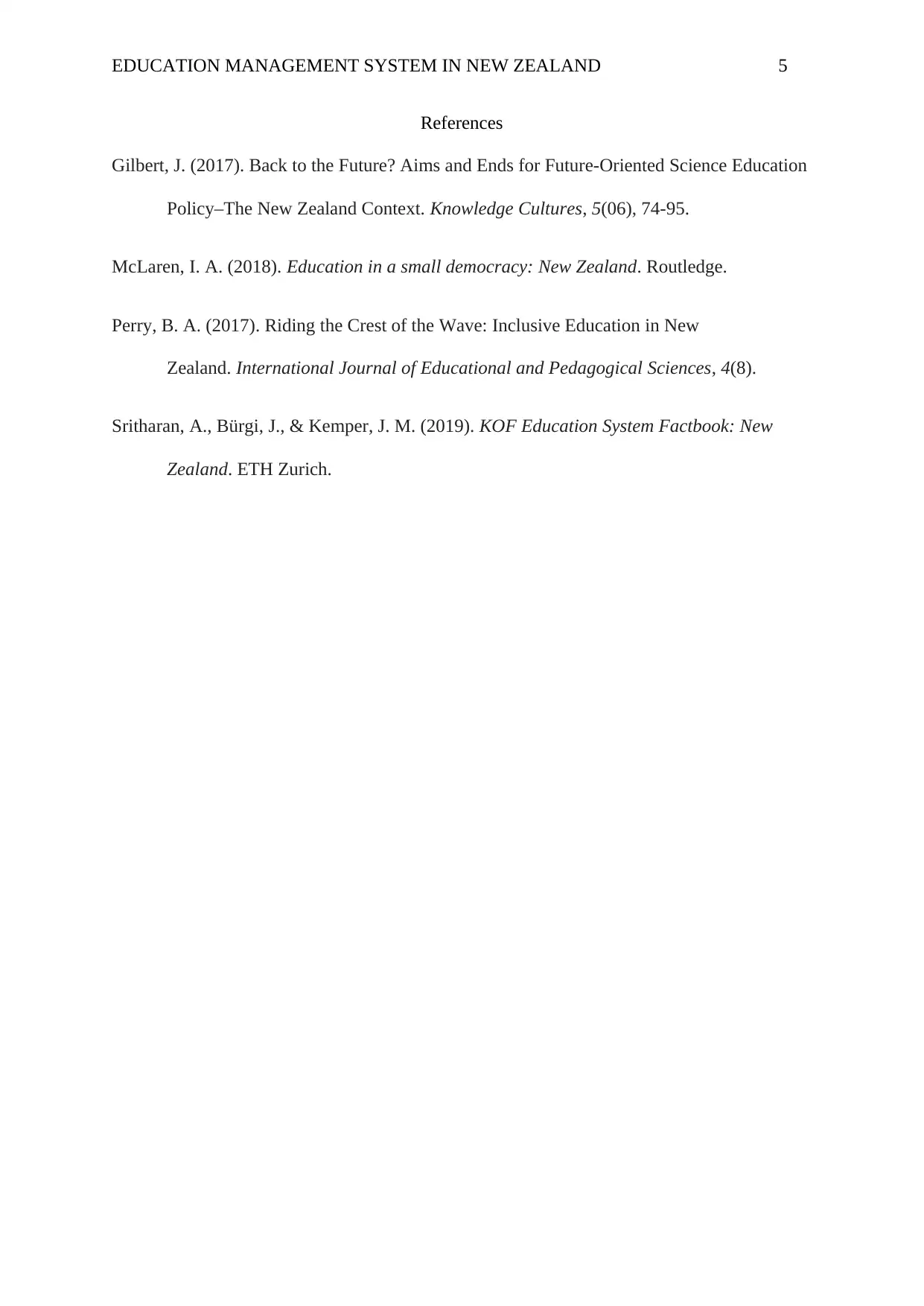
EDUCATION MANAGEMENT SYSTEM IN NEW ZEALAND 5
References
Gilbert, J. (2017). Back to the Future? Aims and Ends for Future-Oriented Science Education
Policy–The New Zealand Context. Knowledge Cultures, 5(06), 74-95.
McLaren, I. A. (2018). Education in a small democracy: New Zealand. Routledge.
Perry, B. A. (2017). Riding the Crest of the Wave: Inclusive Education in New
Zealand. International Journal of Educational and Pedagogical Sciences, 4(8).
Sritharan, A., Bürgi, J., & Kemper, J. M. (2019). KOF Education System Factbook: New
Zealand. ETH Zurich.
References
Gilbert, J. (2017). Back to the Future? Aims and Ends for Future-Oriented Science Education
Policy–The New Zealand Context. Knowledge Cultures, 5(06), 74-95.
McLaren, I. A. (2018). Education in a small democracy: New Zealand. Routledge.
Perry, B. A. (2017). Riding the Crest of the Wave: Inclusive Education in New
Zealand. International Journal of Educational and Pedagogical Sciences, 4(8).
Sritharan, A., Bürgi, J., & Kemper, J. M. (2019). KOF Education System Factbook: New
Zealand. ETH Zurich.
1 out of 5
Related Documents
Your All-in-One AI-Powered Toolkit for Academic Success.
+13062052269
info@desklib.com
Available 24*7 on WhatsApp / Email
![[object Object]](/_next/static/media/star-bottom.7253800d.svg)
Unlock your academic potential
Copyright © 2020–2025 A2Z Services. All Rights Reserved. Developed and managed by ZUCOL.




